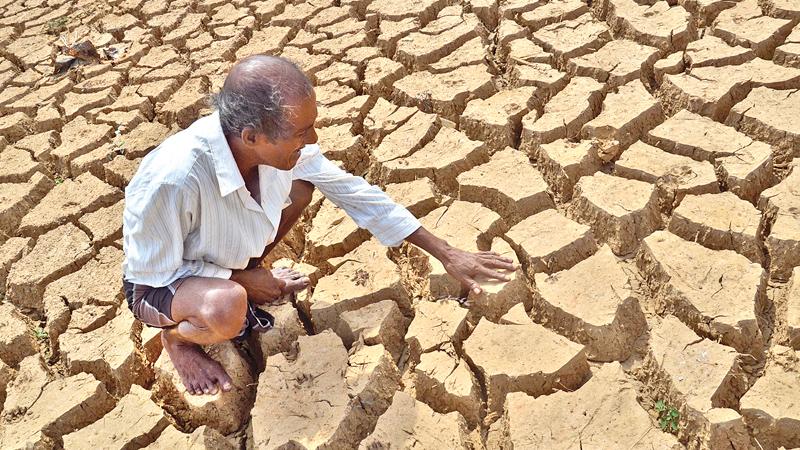
Climate change adaptation is increasingly being viewed as a priority area in several economic sectors, given the fact that changes in weather patterns are more visible today and agriculture has been identified as a highly vulnerable sector, Founder Chairman, Munasinghe Institute for Development and Chairman of the Presidential Panel of Experts for 2030 Vision for Sustainable Development, Prof. Mohan Munasinghe said.
Speaking at a workshop on ‘Climate insurance for dry zone farmers in Sri Lanka’ at the Institute of Policy Studies of Sri Lanka in Colombo last week, he said that a robust integrated strategy is needed to move forward in facing climate change.
“Look at the issues of long term land segmentation. Food and water impact are severe. The ecosystem impact and extreme events result in climate change. The temperature and sea level rise too has a negative effect on agriculture,” he said.
Specifically, dry zone agriculture is facing issues due to variations in usual rainfall pattern and increased frequency and severity of natural disasters such as floods and droughts.
From a policy perspective, it is important to take appropriate action to manage the disaster risks effectively. Though climate change may not be the only factor affecting the occurrence of such extreme events, it is high time to have a comprehensive framework to address the vulnerability issues which are on an increasing trend, he said.
“This calls for the need for having research-based information with regard to risk management strategies of farmers. Moreover, climate insurance is now a lot debated subject as a tool for climate adaptation. However, there has been minimal research carried out on these aspects in Sri Lanka,” Prof. Munasinghe said.
It is very important to address climate change. Social and economic policies should be integrated into the main steam policy framework. The economic and social dimensions of an insurance plan should be taken in to account and there should be a balance between these two aspects and the link that binds this is human capital, he said.
“Wrong social values drive unsustainable development which in turn will drive economic mal-development. It is important to build democratic space for sustainable development for the betterment of the country and well-being of the people,” he said.
Presenting research findings on the climate insurance as a risk management strategy for dry zone farmers in Sri Lanka, Kanchana Wickramasinghe said that dry zone agriculture in Sri Lanka is found to be highly vulnerable to the impacts of climate change.
“Variations in the rainfall pattern and the incidents of droughts and floods have been more frequent recently. Rain fed farmers are particularly at risk of changing rainfall. Climate risk bring in additional challenges for dry zone agriculture,” she said.
Given the increasing risks and uncertainties due to climate change, it is important to understand the risk management strategies of farmers in facing the climate related risks and uncertainties. Among others climate insurance has increasingly been discussed as a risk management strategy. Thus, it is interesting to assess climate insurance as a risk management strategy for dry zone farmers in Sri Lanka.
“Borrowing, is the most commonly adopted coping strategy. Under that, pawning jewellery was the most observed strategy as nearly half of the surveyed farmers pawn jewelries.
“Around eight percent of households work as labourers in agriculture activities. Farmers highlighted that they face a cyclic pattern of borrowing in the beginning and repaying them at the end of the season. Repayment is a big problem that farmers face when they lose their agricultural income following climate related impacts.
“Therefore, farmers are faced with a vicious cycle of debts. Climate insurance is a good mechanism to address the issues with regard to repayment following a climate related disaster and break the vicious cycle,” she said.
According to the Central Bank Annual Report 2015, the voluntary crop insurance programs covered less than 4 percent of the paddy cultivated areas during 2003 to 2015.
Lack of trust, lack of education and awareness are major issues for this. In most of the cases, crop insurance is obtained as a requirement in getting agricultural loans.
The compulsory crop insurance program introduced in 2013 by the government, which was bundled with fertilizer subsidy program covered 72 and 90 percent of paddy cultivated area during 2014/15 Maha and 2015 Yala respectively.
The research explains the opportunities for index based climate insurance and as per the farmer experience in regard to bad years in the past and the compatibility of such information with historic data there is a technical feasibility in implementing index based climate insurance in Sri Lanka.
Index based climate insurance when introduced with a proper education and awareness component has the ability to overcome issues related to available indemnity based insurance. This also calls for the need to establish an adequate number of rain gauge stations to minimize basic risk. It is also important to have a long historical record of reliable rainfall data, which is available for certain locations in Sri Lanka.
“Climate insurance can complement the other risk management strategies, specially borrowings from formal and informal sources. A fully subsidized pilot index-based insurance introduced in the Batticaloa district shows the need for proper farmer education, trust building and implementation of rain gauge stations specifically for index based insurance,” Wickramasinghe said.
